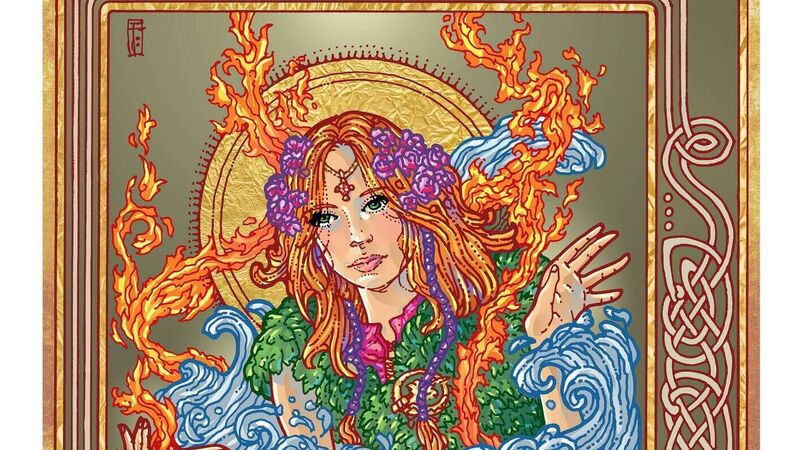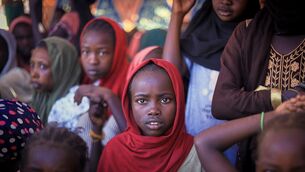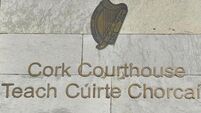Brigid’s Day can be Ireland's first holiday to celebrate a woman

Brigid, as portrayed by artist Jim Fitzpatrick.
"The goddess Brigid is a bridge, crossing the threshold from Celtic to Christian, north and south, winter and spring, water and fire, masculine and feminine" — Treacy O'Connor.
Herstory's campaign to make Brigid's Day Ireland's new public holiday is gathering momentum. The petition has been signed by 11,000 people, with backing from the Women's Parliamentary Caucus, Green Party, Official St Patrick's Festival, Joe Duffy, Marian Keyes, Imelda May, Ceann Comhairle Seán Ó Fearghaíl, Senator David Norris, Holly Cairns TD, Ivana Bacik TD, Josepha Madigan TD, Martin Heydon TD, Frances Fitzgerald MEP, Charlie Flanagan TD, and Maria Walsh MEP.
February 1 is the ancient Celtic Festival of Imbolc, celebrating the first day of spring. It was also known as the feast of the pre-Christian Celtic goddess Brigid, one of the founding goddesses of the Tuatha Dé Danann. Brigid is synonymous with healing and is a symbol of compassion.
The victims and heroes of the pandemic could be honoured by making Brigid's Day and Imbolc our new public holiday.
February is off-peak for tourism. Nothing happens in Ireland between New Year's Day and St Patrick's Day. There are no holidays during the most depressing period of the year.
Ireland is the only country that follows the Celtic calendar and already we have public holidays in and around the other three seasonal Celtic festivals: May Day, for Bealtaine, the August public holiday on Lughnasa, and the last Monday of October, coinciding with Samhain. Imbolc is the missing one.
Our ancestors understood the importance of marking the end of winter and celebrating spring, the return of the light, and the chance to plant new seeds. It is a time for rebirth and renewal, an opportunity to dream, to imagine our future, as citizens and as a nation.
The 1916 Rising leaders, John Moriarty and John O'Donohue, honoured and shared the Celtic wisdom tradition, highlighting its relevance and inspiration as a guiding force for modern Ireland.
As we near the end of the Decade of Centenaries, Brigid's Day and Imbolc are a time to acknowledge how far we have come in 100 years; and the enormous courage to face our troubled histories and the recent challenges of the pandemic.
As a nation, we are emerging from the pandemic as 'the first and best country that has learned to live with Covid since January of this year'. From the darkest history — a perpetual winter of colonialism, famine, mass emigration, civil war, and poverty — we are rising to be a world leader of peace, prosperity, and liberal progress. In one generation, Ireland has transformed from 'no country for women' to a nation with a growing international reputation for equality, diversity, and inclusion. Today, there are major issues in Irish society, notably the housing crisis, homelessness, direct provision, and domestic violence. There is much work to be done, but we have come a long way.
In the spirit of spring, this is just the beginning.

Ireland has three public holidays dedicated to men: To Jesus, to Stephen, and to Patrick. In the 21st century, we are waiting for a public holiday to celebrate an Irish woman and mná na hÉireann. If Ireland lights up the world green for St Patrick's Day, surely we should be illuminating in honour of women. That's why I started the Herstory Light Festival. It is time to finally realise the 1916 vision that made Ireland the first country in the world to promise "equal rights and religious freedom to all men, women, and children". Just like St Patrick’s Day was made a global success by our cherished diaspora, the Irish abroad are leading the way with Brigid's celebrations. From Warsaw to Washington, Irish embassies and Irish cultural centres mark the day with events honouring women around the world.
Brigid was an Ulster goddess and a Leinster saint, an All-Ireland, all-island icon. If this new public holiday is St Brigid's Day — focusing on Brigid as saint only — we lose the Celtic wisdom connection to spring and limit the potential for celebrations with Northern Ireland. On Brigid's Day, Herstory illuminated iconic landmarks across Ulster, including Belfast City Hall, Ulster Museum, Titanic Museum, Enniskillen Castle, and Derry Tower Museum.
A unifying force for Europe long before the saint, Brigid was a pan-European goddess, celebrated from Spain to Turkey. Today, when Brexit threatens the stability of the EU, Brigid's Day is an opportunity to reunite with our European neighbours and reaffirm our commitment to the founding values of the European Union, one of the most successful and enduring peace projects in modern history. Brigid's Day could become a pan-European bank holiday.
There has been some resistance to our new public holiday having a connection to the Catholic Church. This is understandable, given the trauma and abuse that we, as a nation, are still processing. However, it's important to highlight that St Brigid came from the early Irish Christian tradition, which was far more progressive than today's Catholic Church. Brigid is the embodiment of true Christianity, renowned for her compassion, healing gifts, and care for the poor and sick.
The saint is an anomaly for modern Catholicism, in that she is recorded by medieval monks in the annals as both Ireland's first abortionist and a lesbian. It’s hardly surprising that Brigid re-emerged as a timeless icon for the marriage equality and abortion votes, both victories of compassion.
In , her biographer, Cogitosus, recorded that Brigid formed an alliance with the hermit Conleth and, together, they created a double monastery from the Early Christian tradition. She was abbess and he was bishop. Within 100 years of her death, there was a thriving, egalitarian monastery of men and women, living and practising their spirituality equally, side by side. Ireland has much to remember and to learn from Brigid and from the wisdom of our past.
Brigid was Celtic goddess, Christian saint, and a symbol of feminine power and compassion, who transcends religion or spirituality, making her inclusive and appealing for all faiths and none.
Making Brigid's Day and Imbolc our new public holiday would give citizens the opportunity to come together every year on the first day of spring, to celebrate how far we have come, plant new seeds, and imagine our shared future.














